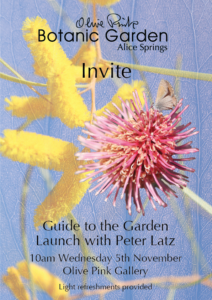
Our inland journey to do some research on the Australian pioneer Olive Pink was done in early March before the Pandemic had been declared. We were aware of the virus but flying inland seemed very innocent. By the end of the week flying back to Sydney, it was not innocent – we felt on tender hooks to get home. How things can change in one week.
However in that week of pandemic-innocence we had very rewarding visit with Brekky at the Bean Cafe in the garden with the wallabies and birds and then each day the walks. Later in the day visiting other channels of research. We stayed in the Mecure Motel by the Todd River and behind the Gardens
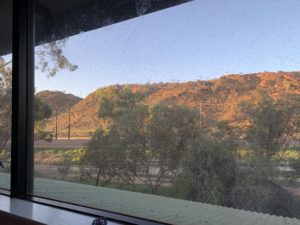
Olive Pink Botanic Garden, Alice Springs
The Garden
Today we treasure a globally unique arid zone botanic garden and continues to work towards Miss Pinks vision:
. . .forty-nine acres of ground on which to preserve and grow native trees, shrubs and flowers – as a ‘soul-feeding antidote to the restless rush and materialism of what ‘modern living’ entails for so many in this isolated town. from Fran Kilgariff
Nestled in the valley of Annie Meyers Hill and bordered by the Todd River is where you will find the Olive Pink Botanic Garden. Its close proximity to the CBD of Alice Springs, Northern Territory, allows visitors and locals alike convenient access to the 16 hectare Garden including the 6 hectares of arid zone plantings in the valley floor and the native vegetation of the encircling hills.
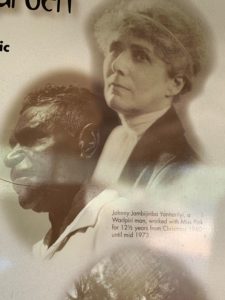
Founded in 1956 by Miss Olive Muriel Pink (1884-1975), the Garden was originally gazetted as the Australian Arid Regions Native Flora Reserve with Miss Pink as the Honorary Curator. Prior to this Miss Pink had studied the anthropology of both the Arrernte and Walpiri people and was a great agitator and advocatefor Aboriginal rights, which lead to her insisting that Aboriginal gardeners receive employment conditions under the award. Jampitjimpa Yannarilyi (Johnny) was one of the Aboriginal gardeners whom Miss Pink held in high esteem and was employed in the Garden from 1960 for a period of 12 years.,
From the time of Miss Pink’s death in 1975 until 1985, like minded people rallied to keep Olive’s Mission alive. Local gardeners, water-conservationist John Blakeman, orthonologist Barry Bucholtz and many towns folk with many developments to preserve the garden as viable. The garden and the Bean Cafe and were opened to the public in 1985as the Olive Pink Flora Reserve, and in 1996 it was renamed to more accurately reflect its purpose as the Olive Pink Botanic Garden. A voluntary seven person Board of Trustees manages the Garden. They draw on experience and expertise in commerce, science, law and tourism and are responsible to the NT Minister for Local Government. On my recent visit I met the present curator Ian Coleman. I had an immediate rapport with Ian as he spoke of his understanding of Olive Pink’s vision and understanding for the park. He has the sensibility of a spirituality and a philosophy of the story of the land on which the garden stands.

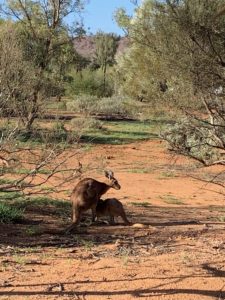

Some aspiring and educational walks wander through the park.
1. An historical walk called the Olive Pink Walk,
2. the Mulga Woodland walk,
3 the Mallee Walk
4 The Arrernte Trail and the marvellous challenging for us (no longer spritely) called 5. the Annie Meyers Hill walk .
There are Bird groves specialising in bird feeding trees, many seats to sit and enjoy the peace and educational nodes with very informative coloured and modern stories. Education is a key element of the Garden’s ethos with information available about the evolution of Australia’s arid zone flora, the traditional use of plants by Aborigines and local history in the graphic displays housed in in shelter nodes along the tracks.
Another valuable treasure is Peter Latz a renowned Central Australian botanist and garden volanteer. as he says at the end of an article he wrote,
Decades of dedicated work by Olive Pink, Jampiijinpa (Johnny) and other staff as well as countless volunteers has gone into producing this globally unique treasure -trove of bio-diversity and store of potential foods and medicinal cures
The Botanical Garden Newsletter for botanical gardens of Australia and New Zealand. No. 3 July 2002
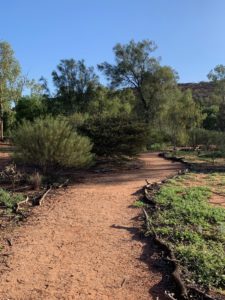
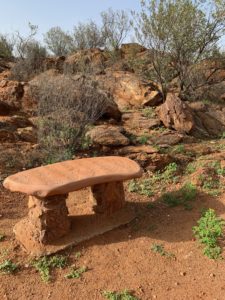
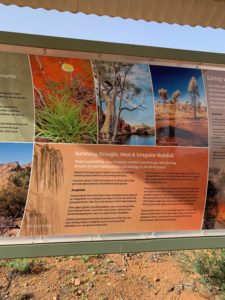
|
The Blakeman Shelter |
|
Livistona palms at the Garden waterhole |
The Blakeman Shelter |
Livistona palms at the Garden waterhole |
The Garden
Nestled in the valley of Annie Meyers Hill and bordered by the Todd River is where you will find the Olive Pink Botanic Garden. Its close proximity to the CBD of Alice Springs, Northern Territory, allows visitors and locals alike convenient access to the 16 hectare Garden including the 6 hectares of arid zone plantings in the valley floor and the native vegetation of the encircling hills.
Founded in 1956 by Miss Olive Muriel Pink (1884-1975), the Garden was originally gazetted as the Australian Arid Regions Native Flora Reserve with Miss Pink as the Honorary Curator.
